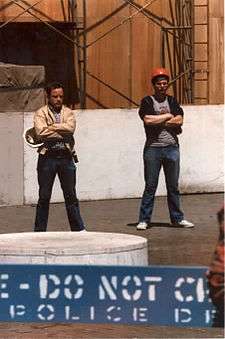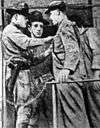Union violence
Union violence is violence committed by unions or union members during labor disputes. When union violence has occurred, it has frequently been in the context of industrial unrest.[1] Violence has ranged from isolated acts by individuals to wider campaigns of organised violence aimed at furthering union goals within an industrial dispute.[2][3][4]
Anti-union violence has also occurred frequently in the context of industrial unrest, and has often involved the collusion of management and government authorities, private agencies, or citizens' groups in organising violence against unions and their members.[5][6][7][8][9]

Overview
Protests and verbal abuse are routinely aimed against union members or replacement workers who cross picket lines ("blacklegs" or "scabs") during industrial disputes. The inherent aim of a union is to create a labor monopoly so as to balance the monopsony a large employer enjoys as a purchaser of labor. Strikebreakers threaten that goal and undermine the union's bargaining position, and occasionally this erupts into violent confrontation, with violence committed either by, or against, strikers.[1] Some who have sought to explain such violence observe, if labor disputes are accompanied by violence, it may be because labor has no legal redress.[10] In 1894, some workers declared:
..."the right of employers to manage their own business to suit themselves," is fast coming to mean in effect nothing less than a right to manage the country to suit themselves.[11]
Occasionally, violent disputes occur between unions, when one union breaks another's strike.
Research on union violence
Researchers in industrial relations, criminology, and wider cultural studies have examined violence by workers or trade unions in the context of industrial disputes.[1][12][13][14] US and Australian government reports have examined violence during industrial disputes.[15][16]
By country
Australia
- 1996 - On 19 August 1996, Australian unionists physically broke into the Australian Parliament & fought Australian Federal Police during the 1996 Parliament House Riot.[17][18]
United Kingdom
- 1926 - In the context of the 1926 United Kingdom general strike, striking miners derailed The Flying Scotsman on May 10.[19][20]
- 1972 - British Trade Union representative Ricky Tomlinson, now best known as an actor, was convicted for a two-year term for threatening construction workers.[21]
- 1984 - Taxi driver David Wilkie was killed by striking miners while driving a non-striking worker during the NUM UK mining strike of 1984-85.[22][23]
United States
- 1986 - During protests by the International Brotherhood of Electrical Workers Local 1547 against workers replacing union jobs, picketers engaged in scuffles, chanting and sounding gunshots.[24][25] In 1999, the Alaska Supreme Court ruled that the union had engaged in "ongoing acts of intimidation, violence, destruction of property", awarding the plaintiff $212,500 in punitive damages.[24][25]
- 1990 - on the first day of The New York Daily News strike, delivery trucks were attacked with stones and sticks, and in some cases burned, with the drivers beaten.[2][3][4] Strikers then started threatening newsstands with arson, or stole all copies of the Daily News and burned them in front of the newsstands.[2][3][4] James Hoge, publisher of the Daily News, alleged that there had been some 700 serious acts of violence. The New York Police Department claimed knowledge of 229 incidents of violence. Criminal charges under the Hobbs Act were declined, however, citing the aforementioned Enmons case.[2][3][4]
- 1993 - Eddie York was killed by a rifle shot in the head while crossing a United Mine Workers (UMW) picket line at a coal mine in Logan County, West Virginia, on July 22, 1993. Like the 1990 NY Daily News strike, criminal charges under the Hobbs Act were declined, with the FBI and Justice Department citing the Enmons case.[26][27]
- 1997 - On August 7, 1997, teamsters Orestes Espinosa, Angel Mielgo, Werner Haechler, Benigno Rojas, and Adrian Paez beat, kicked, and stabbed a UPS worker (Rod Carter) who refused to strike, after Carter received a threatening phone call from the home of Anthony Cannestro, Sr., president of Teamsters Local 769.[28][29]
See also
People
References
- Philip Taft and Philip Ross, "American Labor Violence: Its Causes, Character, and Outcome," The History of Violence in America: A Report to the National Commission on the Causes and Prevention of Violence, ed. Hugh Davis Graham and Ted Robert Gurr, 1969.
- The Wall Street Journal, November 2, 1990.
- Michael Gartner, "Nation Shrugs as Thugs Firebomb Freedom," The Wall Street Journal, November 29, 1990.
- The New York Times, November 15, 1990.
- Smith, Robert Michael (2003). From blackjacks to briefcases: a history of commercialized strikebreaking in the United States. Athens OH: Ohio University Press. pp. xvi–xvii, 179. ISBN 978-0-8214-1466-8.
- Norwood, Stephen Harlan (2002). Strikebreaking & intimidation: mercenaries and masculinity in twentieth-century America. UNC Press. p. 328. ISBN 978-0-8078-5373-3.
- Gall, Gregor (2003). "Employer opposition to union recognition". In Gregor Gall (ed.). Union organizing: campaigning for trade union recognition. London: Routledge. pp. 79–96. ISBN 978-0-415-26781-6.
- ITUC. "2010 Annual survey of violations of trade union rights". International Trade Union Confederation. Retrieved 13 June 2010.
- Mixer and server , Volume 12, Hotel and Restaurant Employee's International Alliance and Bartenders' International League of America., 1903, page 44
- J. Bernard Hogg, "Public Reaction to Pinkertonism and the Labor Question," Pennsylvania History 11 (July 1944), 171--199, citing John Bascom, "Civil Law and Social Progress," The Independent, vol. xliv (September 15, 1892), p. 1279.
- J. Bernard Hogg, "Public Reaction to Pinkertonism and the Labor Question," Pennsylvania History 11 (July 1944), 171--199, citing the advisory committee of the Amalgamated Association of Iron and Steel Workers during the Homestead Strike
- Rhodri Jeffreys-Jones (1979), Theories of American Labour Violence, Journal of American Studies, 13, pp 245-264, doi:10.1017/S0021875800011439
- Armand J. Thieblot, Jr. and Thomas R. Haggard, 1983, Union Violence: The Record and the Response by Courts, Legislatures and the NLRB, Industrial Research Unit, Wharton School, University of Pennsylvania.
- Brinker, Paul, Violence by U.S. labor unions, Journal of Labor Research, 1985-12-01, Volume 6, Number 4, p. 417-427
- Closing the Legal Loophole for Union Violence: Hearing Before the Committee On the Judiciary, United States Senate, One Hundred Fifth Congress, First Session, On S. 230 ... September 3, 1997, Washington: U.S. G.P.O., 1998.
- Pinto, Susan; Wardlaw, Grant R. "Australian Institute of Criminology - Political violence". Aic.gov.au. Retrieved 2011-03-27.
- "Archived copy" (PDF). Archived from the original (PDF) on 2012-02-16. Retrieved 2012-06-05.CS1 maint: archived copy as title (link)
- "Title". Anu.edu.au. Retrieved 2011-03-27.
- http://www.railwaysarchive.co.uk/documents/MoT_AnnitsfordCramlington1926.pdf
- "GCSE Bitesize: Chronology of events - the basics". BBC. 1926-05-04. Retrieved 2011-03-27.
- Youngs, Ian (23 September 2014). "Actor battles to overturn jail term". BBC News. Retrieved 2018-07-27.
- "BBC ON THIS DAY | 16 | 1985: Miners jailed for pit strike murder". BBC News. May 16, 1985. Retrieved 2011-03-27.
- Tim Jones, "Miners get life for taxi murder", The Times, 17 May 1985
- Kent Morlan. "Alaska Utility Construction Inc. v. International Brotherhood of Electrical Workers, Local 1547". Morelaw.com. Retrieved 2011-03-27.
- "Nos. S-8207, S-8247. - INTERNATIONAL BROTHERHOOD OF ELECTRICAL WORKERS LOCAL 1547 v. ALASKA UTILITY CONSTRUCTION INC - AK Supreme Court". Caselaw.findlaw.com. Retrieved 2011-03-27.
- "65 F.3d 1137: United States of America, Plaintiff-appellee, v. Jerry Dale Lowe, Defendant-appellant :: US Court of Appeals Cases :: Justia". Law.justia.com. Retrieved 2011-03-27.
- Fitzgerald, Randy, "Murder in Logan County", Reader's Digest, Feb. 1995
- "Beaten UPS Driver Wins Teamsters Settlement - Los Angeles Times". Articles.latimes.com. 1997-08-02. Retrieved 2011-03-27.
- "Foundation Attorneys Sock Teamsters with Racketeering Suit". NRTW. Retrieved 2011-03-27.
